Fry Bread And How It Came To Be
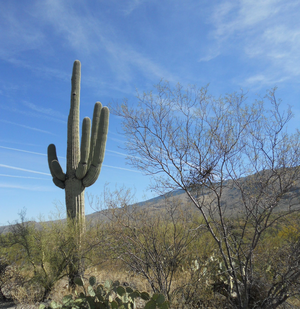 Fry bread is cooked and eaten by many Native American tribes all over the western United States. Recipes for fry bread vary from tribe to tribe and is served with many different accompaniments, including chile beans or topped with taco ingredients for a “Navajo Taco.” Fry bread is also eaten as a dessert with jam, honey, or powdered sugar. Amanda and I were lucky to try this somber dish at the premiere fry bread restaurant in the southwest Fry Bread House in Phoenix, Arizona.
Fry bread is cooked and eaten by many Native American tribes all over the western United States. Recipes for fry bread vary from tribe to tribe and is served with many different accompaniments, including chile beans or topped with taco ingredients for a “Navajo Taco.” Fry bread is also eaten as a dessert with jam, honey, or powdered sugar. Amanda and I were lucky to try this somber dish at the premiere fry bread restaurant in the southwest Fry Bread House in Phoenix, Arizona.
Fry bread is the most recognizable of all Native Americans foods, yet most Americans probably do not know the story of how fry bread was created. For many Native Americans, eating fry bread and remembering the story of fry bread is an important and somber tradition, for the story of fry bread is a story of sadness.
The fry bread recipe was made from the meager flour, eggs, condensed milk, baking powder, yeast, salt, and sugar that was issued to the Navajo in the early prison camp reservations in what is now Western New Mexico. In the 1860’s the Navajo people were brutally forced from their native land into these prison camps by the U.S. Army.
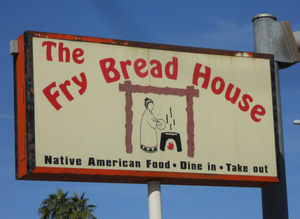 Traditionally the Navajo dinetah, or homeland, was in the four corners region of what is now northeastern Arizona, northwestern New Mexico and southern Utah and Colorado. For hundreds of years the Navajo thrived in this area hunting and farming beans, corn, and squash. After Spanish settlers introduced sheep and goats to North America, raising livestock became an important part of the Navajo way of life.
Traditionally the Navajo dinetah, or homeland, was in the four corners region of what is now northeastern Arizona, northwestern New Mexico and southern Utah and Colorado. For hundreds of years the Navajo thrived in this area hunting and farming beans, corn, and squash. After Spanish settlers introduced sheep and goats to North America, raising livestock became an important part of the Navajo way of life.
By the mid 1800’s a turbulent relationship began between the Navajos and white settlers in New Mexico. Peace treaties were made but often ignored as both settlers and natives launched raids into the others’ territory. Violence escalated during one peace talk between Navajo and the U.S. Army resulting in the death of Narbona, a well respected Navajo leader.
In 1863 the U.S. Army Colonel Kit Carson ruthlessly forced the Navajo surrender through starvation of the Navajo people—burning their homes and crops and killing their livestock. After their surrender, the Navajo people were forced to march over 300 miles on the “Long Walks” to the Bosque Redondo reservation near Fort Sumner in western New Mexico.
Many Navajo died from starvation during the forced march. Once at the reservation the conditions were terrible. The reservation was, in reality, a prison camp. The camp suffered from mass overcrowding and lack of sufficient food and supplies. Navajos in the camp also were subject to constant raids by neighboring settlers and rival Native American tribes. The Navajo were forced to remain in the camp for four years before they were allowed to return to a reservation on a portion of their native land in 1968.
The rations issued by the U.S. army were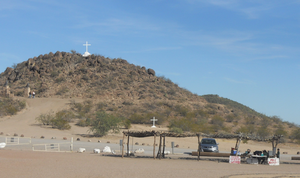 often spoiled or rancid, and completely foreign to the Navajo. Yet, with the care and ingenuity of the Navajo cooks, they created a dish that was substantial and satisfying. Today fry bread is commonly served at Native American homes and pow-wows. Amanda and I even saw fry bread being sold in outdoor booths on a reservation outside of Tuscon, Arizona.
often spoiled or rancid, and completely foreign to the Navajo. Yet, with the care and ingenuity of the Navajo cooks, they created a dish that was substantial and satisfying. Today fry bread is commonly served at Native American homes and pow-wows. Amanda and I even saw fry bread being sold in outdoor booths on a reservation outside of Tuscon, Arizona.
Amanda and I were not aware of this melancholy history when we ate lunch at the Fry Bread House—we were simply able to enjoy some of the country’s best fry bread for the delicious dish that it is. Fry bread is a puffy, doughy, bread that has a distinct southwestern feel and a familiar, satisfying flavor.
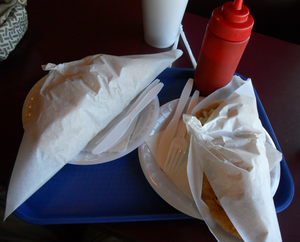 The huge fry bread “tacos” at the Fry Bread House were served wrapped in paper and neatly folded into a triangle for easy eating on the go—definitely intended to be eaten as a street-food. Within this package was the pillowy bread served with an array of topping and ingredients that included green and red chiles, beans, lettuce, cheese, sour cream, beef, and chorizo—not to mention all of the sweet toppings as well.
The huge fry bread “tacos” at the Fry Bread House were served wrapped in paper and neatly folded into a triangle for easy eating on the go—definitely intended to be eaten as a street-food. Within this package was the pillowy bread served with an array of topping and ingredients that included green and red chiles, beans, lettuce, cheese, sour cream, beef, and chorizo—not to mention all of the sweet toppings as well.
I ordered the ultimate taco with green chile. This was a gargantuan assemblage that included nearly all the taco ingredients wrapped up in dinner-plate-sized disc of soft, warm fry bread. All of the ingredients tasted fresh and flavorful and the green chiles added a great complexity and heat to the taco. But even with all the flavorful toppings, this taco was all about the bread.
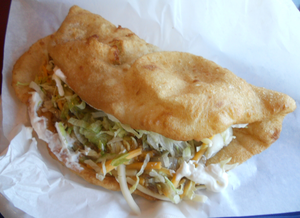 The Fry bread was everything I could have wanted in a warm, doughy treat. The texture was slightly chewy in a very satisfying way— the bread becoming its own entity when eaten with the ground beef and toppings of the taco. The bread had a yeasty, slightly nutty aroma and a deep-fried richness without being the least bit greasy.
The Fry bread was everything I could have wanted in a warm, doughy treat. The texture was slightly chewy in a very satisfying way— the bread becoming its own entity when eaten with the ground beef and toppings of the taco. The bread had a yeasty, slightly nutty aroma and a deep-fried richness without being the least bit greasy.
In Native American culture, fry bread is eaten with the memory of the hardships faced by the Navajo people during the Long Walks, the four long years of U.S. imprisonment in the prison camps, and the hardships that the Native American communities continue to face to this day. Some even believe that fry bread is to be eaten until the land returns to its natural state.
The fact is, fry bread is still so popular today because it is truly delicious. The tastiness of fry bread is a great vehicle for sharing the memory of a largely forgotten part of our country’s history. The creation of the fry bread recipe is a testament to the ingenuity and strength of a people who were met by dire circumstances, and the continued enjoyment of this dish is a prayer of hope shared by all who indulge.


A good history lesson and one of a peoples’ survival. Will make sure to try Fry Bread when next in Arizona.
I love the post. We discussed fry bread quite a bit in the American Indian history class I took a few years ago. You have the beginnings of A People’s Culinary History of the United States.